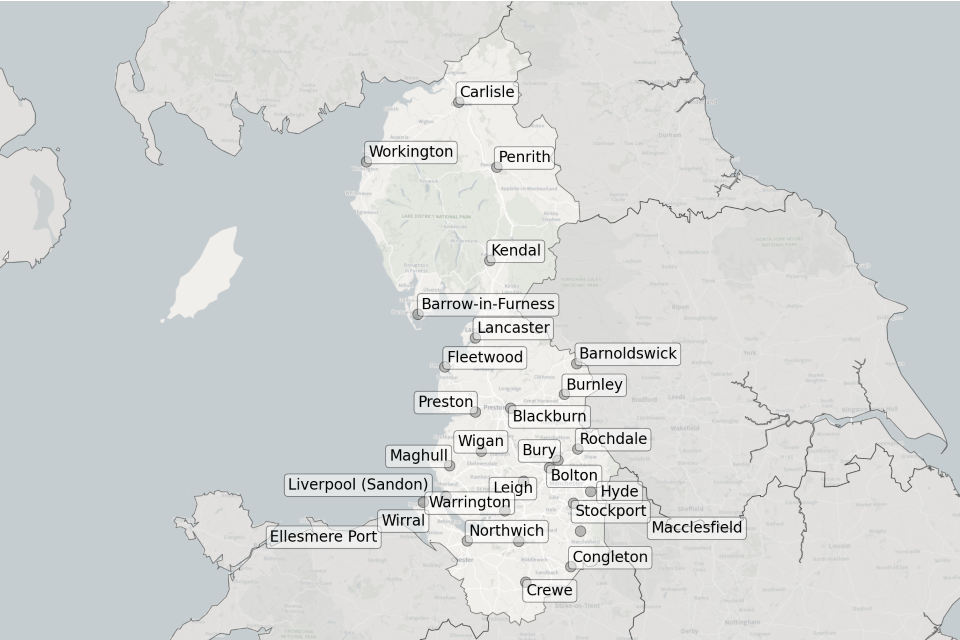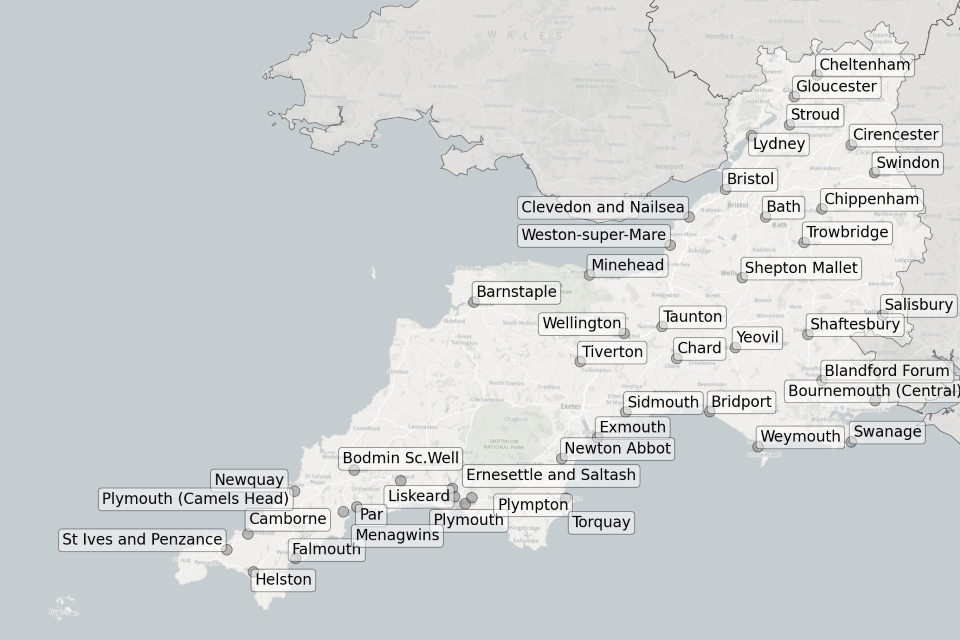Environmental Monitoring For Health Protection (EMHP); wastewater monitoring of SARS-CoV-2 in England: July 2021
Published 26 August 2021
Data showing the concentration of SARS-CoV-2 RNA detected in wastewater by the EMHP wastewater monitoring programme.
Background on the EMHP wastewater monitoring programme
People infected with coronavirus (COVID-19) shed the virus during daily activities such as going to the toilet and blowing noses. The virus enters the sewer system through sinks, drains and toilets. Fragments of the SARS-CoV-2 virus (the virus that causes COVID-19) can be detected in samples of wastewater taken from manholes and sewage treatment works (STWs).
The EMHP programme, led by the Joint Biosecurity Centre (part of NHS Test and Trace), tests sewage for fragments of SARS-CoV-2 RNA. Samples are taken from approximately 270 STWs in England (see figures 1 to 9). Further detail about EMHP wastewater coverage can be found in the publication Wastewater testing coverage data for the EMHP programme.
The programme helps identify where the virus is circulating in England, detecting spikes in prevalence and presence of variants. Findings are reported to national decision makers and local stakeholders on a regular basis, helping to inform national strategy and localised action. Wastewater analysis has the benefit of detecting the virus regardless of whether people have symptoms or whether they have a test. Wastewater monitoring complements other testing programmes and public health actions to help protect against the threat of new variants.
As the threat of variants has emerged, the programme plays an important role in the detection of mutations of the virus, variants of concern (VOCs) and variants under investigation (VUIs). This is achieved through genomic sequencing of wastewater samples, to provide an indication of where VOCs and VUIs may be present across England. Insights from wastewater monitoring are shared with local and national decision makers, to help inform the action that they can take to stop further transmission.
The programme is led by the Joint Biosecurity Centre and run in partnership with the Department for Environment, Food and Rural Affairs, the Environment Agency, the Centre for Environment, Fisheries and Aquaculture Science, academia and water companies. It provides coverage of approximately 40 million people across England. The EMHP team coordinates with programmes in the devolved administrations to provide UK-wide wastewater monitoring.
Concentration of SARS-CoV-2 RNA in wastewater samples; 28 June to 26 July
Data is available in the accompanying spreadsheet ‘EMHP wastewater concentration data: July 2021’. Table 1 contains the weekly average concentration of SARS-CoV-2 RNA (gene copies per litre) in wastewater at all STWs EMHP sample (date range of 28 days; 28 June to 26 July). This data is visualised in figures 10 and 11.
Between week 1 and week 2, there was generally a decrease in concentration across England (there was a decrease in the weekly average at 179 of 262 STWs). There was generally an increase from week 2 to week 3 (there was an increase at 238 of 262 STWs), and relatively consistent concentration from week 3 to week 4 (average concentration increased at 134 STW and decreased at 128 STWs). However, these trends are not consistent across all sites and there is variability between STWs. Furthermore, any interpretation should be made with careful consideration of the points in the the ‘Uncertainty, data quality and revisions’ section below.
Table 2 contains the individual concentrations recorded at each STW. Note that LOD indicates the concentration of SARS-CoV-2 RNA in the sample was lower than the theoretical limit of detection (see the ‘About this data’ and ‘Uncertainty, data quality and revisions’ sections below).
Table 3 shows the number of samples taken at each STW during each week. Note that no samples were taken at Wirral STW during week 2 and week 3, or from Brancote STW during week 2. These STWs have been omitted from Figures 10 and 11 in weeks where no samples were taken.
Figure 1: map showing the location of STWs sampled in the East Midlands

Figure 2: map showing the location of STWs sampled in the East of England

Figure 3: map showing the location of STWs sampled in London

Figure 4: map showing the location of STWs sampled in the North East

Figure 5: map showing the location of STWs sampled in the North West

Figure 6: map showing the location of STWs sampled in the South East

Figure 7: map showing the location of STWs sampled in the South West

Figure 8: map showing the location of STWs sampled in the West Midlands

Figure 9: map showing the location of STWs sampled in Yorkshire and the Humber

Figures 10 and 11: England map showing the location of STWs sampled. Colour indicates the weekly-average SARS-CoV-2 RNA concentration (gene copies per litre). See regional maps for the names of each STW

Methodology
About this data
EMHP sample wastewater from STWs throughout England. Samples are analysed for the concentration of SARS-CoV-2 by quantifying the number of copies of the nucleocapsid gene (N1). Samples are transported to Environment Agency laboratory for quantification of the N1 gene using a process called reverse transcriptase polymerase chain reaction. The data reported here are the number of SARS-CoV-2 N1 gene copies per litre of wastewater (shortened to gene copies per litre throughout this document). Generally, the more people with COVID-19 in the community the more viral RNA will be shed into wastewater. Therefore, the concentration in wastewater is indicative of the prevalence of COVID-19 in the community.
Samples are analysed for the concentration of SARS-CoV-2 RNA and concentration is adjusted for flow (see the ‘Uncertainty, data quality and revisions’ section below). Typically, 4 samples per week are analysed from each STW. However, occasionally fewer samples will be collected and/or analysed. This can be due to several reasons such as EMHP altering sampling strategy because of testing capacity constraints, changing epidemiological priorities and current local response activities.
Data tables 1 and 2 show the concentration of SARS-CoV-2 RNA in wastewater samples (gene copies per litre). Note that there is sensitivity associated with the analysis of wastewater; the limit of detection (LOD) is the minimum concentration of SARS-CoV-2 RNA that can be reliably detected. Data tables contain the values LOD where analysis of the sample did not detect presence of SARS-CoV-2 RNA. For the purposes of averaging data to produce weekly averages in table 1 and figures 10 and 11, EMHP assign a concentration of 160 gene copies per litre to all <LOD samples. This concentration is the theoretical limit of detection and is calculated by the Environment Agency. Note that there is uncertainty in this calculation and continuing work to refine it, please see the “Uncertainty, data quality and revisions” section below for further information.
We are exploring the feasibility of adding more data in future releases, such as regional summaries and detection of variants.
Data Sources
Wastewater samples are collected by water companies and transported to an Environment Agency Laboratory. Concentration data are from Environment Agency analysis of wastewater samples.
Figures in this publication show the location of STWs. These locations were obtained from the European Commission urban wastewater website. Note that names differ between those used in this document and the European Commission urban wastewater website, sites can be linked using the ‘STW Site Code’ in the attached data tables.
The figures and analysis presented will evolve over time to ensure the most relevant information is included and the needs of stakeholders are met. These figures will initially be published monthly, from June 2021, and we will continuously evaluate the frequency and date-range based on need and public interest.
How these figures can be used
These figures and data can be used to view the concentration of SARS-CoV-2 RNA in wastewater, which is indicative of prevalence in the community. Due to factors relating to data uncertainty, EMHP recommend interpretation of this data with other data sources such weekly statistics for NHS Test and Trace (England).
Uncertainty, data quality and revisions
The figures here are compiled by professional analysts and have been quality assured. However, the analytical pipeline to produce this data should still be considered experimental; it is subject to an ongoing quality assurance process. Any revisions to past publications will be in line with Department of Health and Social Care’s revision policy and highlighted in future publications accordingly. The sites from which EMHP sample can change on a regular basis depending on testing capacity, epidemiological priorities and current local response activities. This can result in changes to specific STWs covered. This means the STW included in subsequent publications may change.
This publication shows STWs as single points. Every STW has an associated geographical catchment area (area from which wastewater flows into the sampling location). These catchments are not yet presented in these statistics publications. There is uncertainty surrounding catchment geography, as catchments vary in size and population covered and in some cases an STW may not be located within the catchment it serves (for example, if wastewater is pumped to the STW). Therefore, the location of STW should be used as a general guide only. For this reason, EMHP do not recommend averaging together STW in a single area to obtain region-level figures.
Wastewater is an inherently variable material and can change greatly within and between days (foodstuffs being consumed; when washing machines are switched on and many other factors), the physical infrastructure and the type and levels of industrial wastes. It is generally more useful to consider trends over medium- and long-term periods of time, rather than between individual days.
There are several factors that can impact the quality of the signal recorded from wastewater and introduce uncertainty, such as:
-
the concentration of SARS-CoV-2 RNA in wastewater may be impacted by weather, for example heavy rainfall wastewater may dilution. EMHP mitigate this by adjusting concentration to consider flow
-
whether samples are ‘composite’ or ‘grab’. Composite samples are where an autosampler (a machine which gathers wastewater at regular intervals over a set time period) gathers wastewater throughout the day. Grab samples are where a single sample is taken at one point in the day and are subject to greater variability; they are influenced by flow characteristics, time of day, and are more susceptible to outliers in the sewage. EMHP aim to mitigate this by sampling during times of peak load and ensuring the sample is collected mid-stream rather than close to the edges or bottom of the pipe
Calculating a LOD (the minimum concentration of SARS-CoV-2 RNA that can be reliably detected in a wastewater sample) can be achieved by several methods. In this data we have used the Theoretical LOD as calculated by the Environment Agency. The Theoretical LOD uses several assumptions. Laboratory data is required to inform the more realistic Practical LOD. The Practical LOD for this analysis is not yet reported here. It is likely that the LOD used in producing these statistics will change in future publications. EMHP will clearly state when this occurs.
Although the exact value of the LOD is uncertain, it is unlikely to have a noticeable impact on the interpretation of this data. This is because the difference between Theoretical and Practical LOD is relatively small, with most impact at low levels of the target being measured.
As explained in the ‘About this data’ section above, typically 4 wastewater samples are taken at each STW per week. The average of all samples within the week is presented in table 1. Uncertainty occurs where fewer samples are taken. For example, if only one sample is taken during a week, that one sample defines the week average. This means weeks with fewer samples are more susceptible to variability and outliers. Table 3 shows how many samples were taken at an STW for each week in this release.
For the above reasons EMHP advise caution when directly comparing data between STWs.
If you would like to give user feedback please email [email protected]
